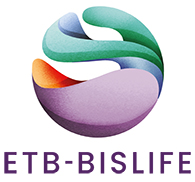ETB-BISLIFE invests in the development of the types of skin tissue that are geared towards existing treatment methods and treatment methods that are being developed. The treatment method and the type of wound determine which type of skin tissue (plain/meshed) is more suitable.
- Chronic wounds
- Second-degree burns (hot water burns)
- Third-degree burns
- Sandwich grafting
- Meek method
Chronic wounds
GPA donor skin is very useful when preparing chronic wounds for treatment with autografts, for instance in patients with venous ulcers. The donor skin has a cleansing effect and promotes the formation of granulation tissue on the wound bed. A key aspect is the significant pain reduction. When the donor skin starts to adhere to the wound bed, it is viable enough for autografting.
Treatment method
After the wound bed has been cleaned, for example with a gauze soaked in NaCl 0.9%, the wound is covered with donor skin. Special fixation is not required; a light, absorbent dressing will be sufficient. If necessary, compression therapy can be used. The glycerol preserved donor skin must be replaced on a regular basis: every 24-48 hours as of the start of treatment. After a number of days, longer intervals between dressing changes may be used.
Second-degree burns
The donor skin is used as a biological dressing. Due to the capillary stasis of the wound bed it may dehydrate during the first 48 hours after the burn occurs, causing the burn to become deeper. Immediate treatment with donor skin (within six hours after the occurrence of the burn) can prevent this from happening. The burn should preferably not be treated with an ointment or balm. If it has, the wound must be rinsed thoroughly first.
The patient will experience significant pain reduction soon after being treated with the donor skin. Initially the donor skin will adhere to the wound like a flexible scab. In most cases, rapid, high-grade epithelialisation will occur beneath this scab. After that, the dried-out scab will come off.
Third-degree burns
After surgical removal of the necrotic tissue, the wound is covered with an autograft. If a patient has little healthy skin available for transplantation, this autograft will be meshed at a ratio of at least 1:4. In that case, the wound bed will be exposed and will be quite vulnerable. There is a significant risk of infection and dehydration. This will also be the case if there is an extensive wound with skin islands (Meek-Wall).
Sandwich grafting
Donor skin is placed on the autograft, so that it covers the exposed parts of the wound bed. Donor skin will promote fast growth of the autograft. For this treatment, the donor skin always has to be meshed. This improves exudate drainage. Donor skin with a mesh ratio of 1:1.5 is provided specifically for this sandwich grafting method. 1:1.5 donor skin is used in most clinics, as it offers the desired result.
However, a number of clinics have had excellent results with 1:3 donor skin. Because the reduced antigenicity of the glycerol-preserved donor skin results in a mild rejection response, the autograft’s growth is not interfered with. The donor skin will form a flexible scab in this case. This scab will adhere to the wound bed and will act as a long-term wound cover. In this scab, the surface will split open, so that the underlying autograft grid can grow out (creeping substitution). This results in complete wound closure within 4 to 5 weeks.
After the cleaned wound has been covered with the stretched-out autograft, the donor skin is applied. It is important that no gaps appear. The donor skin is fixated using skin glue, and stapled. Wet gauze and a dressing are applied to the entire affected area. During the first five days, wound inspection can occur up to the level of the fixation material.
Meek method
For this method, the autografts are cut into small islands (micrografts of 3 x 3mm), resulting in an expansion of 1:9. These islands are fixated on pre-folded gauze dressings using an adhesive. When the dressing is unfolded, the islands will be at equal distances from each other, so that large wounds can be covered with a small number of autografts. The unfolded gauze dressings are applied to the wound areas and joined together. After four to five days, the islands will have grown into the wound to such an extent that the gauze can be removed. The micrografts can be covered with the meshed donor skin. This will result in rapid epithelialisation.
Advantages of the Meek method over meshing:
1. A larger wound surface can be covered (greater expansion).
2. The islands are not connected, so that a local infection will not be able to spread.
3.The distance between the islands is smaller than the open space when using a 1:6 mesh. This accelerates the healing process.
4. Any small piece of autograft can be used, while for the mesh method whole sheets of skin are used.
The disadvantage of this method is that donor skin cannot be used until a few days later, requiring additional surgery. In practice, it has been shown that this does not slow down the wound healing process.
